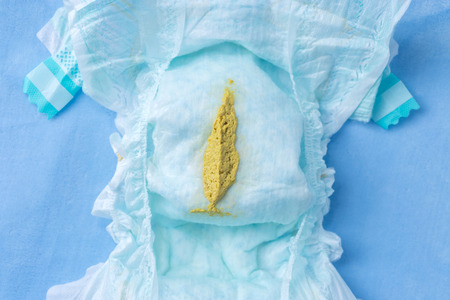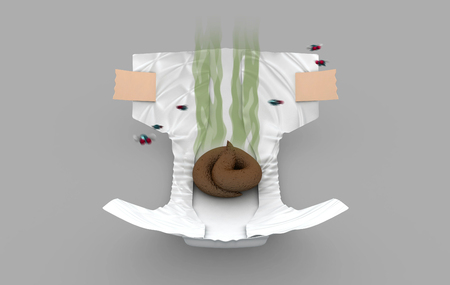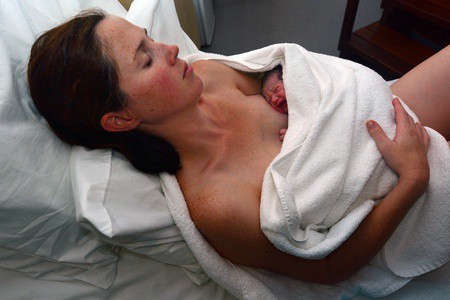Baby Poop – What is Normal and Abnormal Poop?
If you are a new parent, this is one thing you are going to be worried about at some point of time during the first year of your baby’s life. Baby poop is of various colors and consistencies. It is useful to know what is normal poop first so that you are able to identify abnormal baby poop.

What is Normal Baby Poop?
In newborn babies, normal poop of a breast fed infant will be yellowish, thin in consistency and seedy. In case of formula fed babies, the stool will be denser, darker in color and not seedy. This is because formula is more difficult to digest as compared to breast milk. Another thing that may worry parents is the frequency of the stool. Some babies may pass stool after every meal and others just once in a week. Both of these are normal unless the baby shows no signs of discomfort. In breast fed babies, a frequency (baby bowel movement) of once in 7 days and 7 times in a single day is totally normal. The frequency is much less in formula fed babies.
Types of Baby Poop and What They Indicate
The color of poop or the presence of blood in it may worry parents. Here is a guide to baby poop with the different types of poop you may see.
- Newborn Poop: Newborn poop guide may be a topic that interests you. The first stool that your baby passes is called meconium. Meconium looks like a sticky, greenish, tarry stool resembling motor oil. It is made up of the wastes that were present in the intestines of the baby when it was inside the uterus. It contains amniotic fluid, mucus, skin cells and hairs that were shed of by the baby in the womb. There is no peculiar smell to it.After 1-2 days, once the meconium has been removed from the body, and the child has begun taking breast milk or formula, the stool will change to a light green and gradually yellow. This is called as transition stool and it indicates that the baby’s intestines have started functioning normally.
- Breastfed Baby Poop: Normal healthy breastfed baby poop is seedy and yellowish green in color. The consistency is creamy and it is slightly runny. The seeds in baby poop are the unique characteristic of breast fed baby poop.In case, your breastfed baby has a more greenish stool than yellowish, then it indicates that the baby is getting more of fore milk which is the watery part of the milk that the baby gets while he begins feeding. This is followed by the hind milk which is thick and contains fat. If you do not feed at each breast for long enough then the baby will get only the fore milk which contains no fat. Once you notice such a poop in your newborn, make a conscious attempt and feed at one breast till you feel it is completely empty and then offer the next breast. Newborn bowel movements can be as frequent as after each feed and that is totally normal.
- Formula Fed Baby Poop: Formula fed babies have brownish to greenish stools. The stool consistency is dense and butter like. There is a peculiar smell but not as foul smelling as babies who are on solid foods. Since formula is heavier to digest as compared to breast milk, the frequency of the stool is also less.
- Solid food Poop: As soon as the baby turns six months, solid foods like fruit and vegetable purees are introduced. If your baby is breast fed along with solid foods, then the poop will be dark yellow to brown in color. There is a new characteristic and that is the smell. The stool will have a foul smell which will increase as you introduce newer foods to the baby. The consistency of the poop will be mushy. If the baby is unable to digest a particular food, it may lead to constipation and passage of small hard brown ball like poop. During weaning phase, it is best to give the baby only one new food at a time for at least 3 days so that you know if it suits him or not.When the intestines of the baby are not totally mature, you may see small pieces of undigested food in the stool. These pieces of carrots or reddish color due to beet etc are totally normal.
- Iron fortified Poop: If your baby is on iron supplements, then the color of the poop will be greenish or black in color. If the color of the stool is such without intake of iron supplements, then it could indicate a GIT bleed. The doctor would like to rule out melena.

Abnormal Baby Poop
- Constipation: Constipation is seen in the form of hard pebble like stools. The baby will have signs of discomfort when passing the stool with or without a little blood around the anus. Occasional pebble like stool in the diaper is not alarming. But if the baby has these kind of stools consistently, it can indicate milk or soy protein intolerance, sensitivity to some food, cows milk or formula that has been newly introduced in the diet. The child should be given plenty of water and fruits like prunes to help him with the constipation.
- Diarrhea: Watery stools that contain more water than solids are called as diarrhea. Breast fed infants have runny stools resembling diarrhoea but it does not cause any kind of weakness.If the baby has exploding liquid stools that are greenish, yellow or brown the it could indicate an allergy or infection in the body. The water loss from the body during diarrhoea can lead to weakness in the baby and the water needs to be replenished with oral rehydration solution. The cause should be identified and the diarrhoea should be checked immediately. You may check the images of diarrhea in babies in online baby websites.
- Poop With Blood Or Mucus: Little amount of blood could be as a result of a tear in the anus. Frank blood in the stool could be a sign of bacterial infection like dysentery. Blood in the stool can also indicate milk protein allergy.Mucus in the stool is seen as slimy or sticky strings along with the stool. It can be seen if the baby has a cold and has been swallowing mucous. If the mucous in the stool is excessive, it could be a sign of infection.
- Black Poop: Blackish stools means that the baby is swallowing blood and it has been digested within the intestinal tract. It could be blood that comes out of the mothers cracked nipples. The only thing that needs to be ruled out for baby stool black is that the blood is not coming from the baby’s intestinal tract.Infant black poop that is firm in consistency, could be a sign of melena (digested blood that is coming from the baby’s intestines)
- Pale Poop: If the baby has white poop (pale or chalky white) it is a sign of liver or gall bladder disease. These abnormal presentations mostly indicate a medical problem in the background and should be investigated at the earliest.



